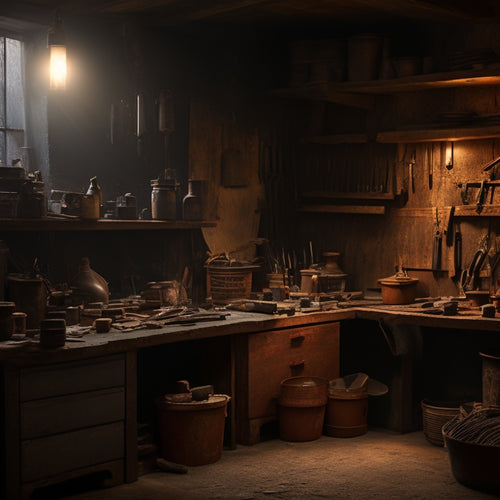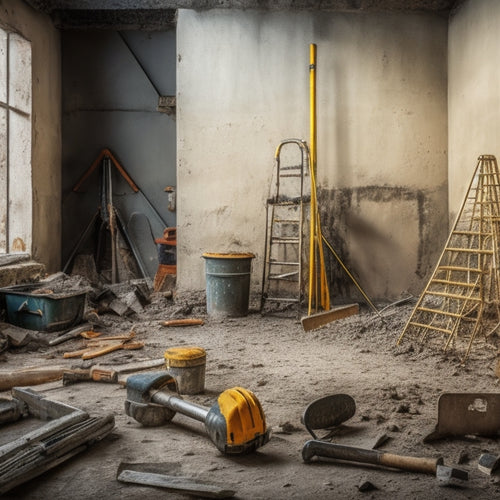
3 Best DIY Cutting Tools for Home Renovations
Share
You'll need the right cutting tools to tackle your DIY home renovation project efficiently, and three essential tools stand out for their versatility and effectiveness: a concrete saw for bulky cutting tasks, a circular saw for precise cuts, and a rotary hammer drilling bit for drilling into hard materials. A concrete saw, like a walk-behind or handheld model, is perfect for large-scale or smaller cuts, respectively. A circular saw offers portability and versatility for cutting concrete, asphalt, and masonry. Meanwhile, a rotary hammer drilling bit, with its carbide-tipped or diamond-coated design, is ideal for drilling into concrete, tile, or stone. By understanding the capabilities and applications of these cutting tools, you'll be well on your way to achieving professional-grade results in your DIY renovation project.
Key Takeaways
• For DIY cutting tasks, concrete saws are essential for efficient cutting, with walk-behind saws suited for large-scale cuts and handheld saws for smaller precise cuts.
• Circular saws offer portability and versatility for cutting concrete, asphalt, and masonry, with blade selection key for achieving optimal cutting results.
• Diamond blades are necessary for abrasive concrete material, and blade size and arbor compatibility are critical for safe operation.
• Rotary hammer drilling bits are crucial for drilling in hard materials, with carbide-tipped bits recommended for concrete and masonry.
• Protective gear is essential for user safety during operation, including when using circular saws and rotary hammer drilling bits.
Essential Concrete Cutting Tools
When tackling concrete cutting tasks in your home renovation project, you'll need a range of specialized tools to efficiently cut through this unforgiving material. Concrete saws are a must-have, and you'll want to choose the right type for your specific project.
Walk-behind saws are ideal for large-scale cuts, while handheld saws are better suited for smaller, more precise cuts. Regardless of the type, make certain it's equipped with a diamond blade, which is specifically designed to withstand the abrasive nature of concrete.
Diamond blades are available in various sizes and bond strengths, so it's important to select the right one for your saw and project requirements. A higher diamond concentration will result in faster cuts, but may compromise on blade life.
Conversely, a lower concentration will extend blade life but slow down the cutting process. You'll also need to take into account the blade's arbor size, which must match your saw's arbor to guarantee safe and efficient operation.
With the right concrete saw and diamond blade combination, you'll be able to make accurate, clean cuts in concrete, guaranteeing a successful home renovation project.
Circular Saws for Concrete
You'll find that circular saws, particularly those designed for concrete cutting, offer a more portable and versatile alternative to walk-behind saws, allowing you to tackle a variety of concrete cutting tasks with greater ease and precision.
These saws are ideal for making precise cuts in concrete, asphalt, and masonry, and their compact size makes them easy to maneuver in tight spaces.
When working with circular saws for concrete, it's crucial to prioritize circular saw safety. Always wear protective gear, including gloves, safety glasses, and a dust mask, and make certain the saw is properly maintained and stored.
To achieve the best results, focus on blade selection. Choose a diamond blade specifically designed for concrete cutting, and consider the blade's diameter, arbor size, and segment type.
Additionally, consider the following:
-
Select a saw with a high-torque motor to handle demanding cuts.
-
Opt for a saw with a durable, rust-resistant blade guard.
-
Choose a saw with adjustable depth settings for versatility.
-
Consider a saw with a built-in dust collection system for improved visibility.
-
Always follow the manufacturer's guidelines for blade installation and maintenance.
Rotary Hammer Drilling Bits
Selecting the right rotary hammer drilling bits is essential for efficient and effective drilling in concrete, masonry, and other hard materials, as they can greatly impact the speed and quality of your drilling operations.
When choosing drill bits, consider the type of material you're working with and the specific rotary hammer features you need. For example, carbide-tipped bits are ideal for drilling through concrete and masonry, while diamond-coated bits are better suited for drilling through tile and stone.
When selecting a drill bit, look for ones with a robust shank and a durable coating to withstand the high torque and impact of rotary hammer drilling.
You should also consider the bit's diameter, length, and flute design, as these factors can affect its performance and lifespan.
Additionally, choose bits with a high-quality heat treatment to guarantee they can withstand the intense heat generated during drilling.
Frequently Asked Questions
What Safety Gear Is Essential for DIY Concrete Cutting Projects?
When tackling DIY concrete cutting projects, you'll need essential safety gear to protect yourself from hazardous debris and airborne particles.
You'll absolutely require safety glasses with impact-resistant lenses to shield your eyes from flying concrete chips and dust.
Additionally, don't forget a dust mask with a filter designed specifically for concrete dust to prevent respiratory issues.
Can I Use a Circular Saw for Cutting Metal Pipes?
When you're planning to cut metal pipes, you'll need to choose the right tool for the job.
While a circular saw can be effective, it's not the best option for every pipe material.
You'll need to take into account the cutting techniques required for specific pipe materials, like PVC, copper, or steel.
For instance, a diamond-coated blade might be necessary for cutting through thick steel pipes.
Make sure you select the appropriate blade and technique to guarantee a clean, safe cut.
How Often Should I Sharpen My Concrete Cutting Saw Blades?
Did you know that a dull saw blade can increase cutting time by up to 50%? You're on the right track thinking about sharpening your concrete cutting saw blades!
On average, you should sharpen them every 1-3 months, depending on usage. Proper sharpening techniques can extend blade lifespan by 30%.
Focus on maintaining a consistent bevel angle and using the correct sharpening stone to get the job done efficiently.
What Is the Best Way to Clean and Maintain My Cutting Tools?
You know the importance of keeping your cutting tools in top shape.
To clean and maintain them, start by wiping down each tool with a dry cloth to remove debris.
Next, apply a rust-inhibiting lubricant to protect against corrosion.
Store your tools in a dry, organized space, like a tool chest or pegboard, to prevent rust and damage.
Regularly inspect your tools for signs of wear and damage, and address any issues promptly to extend their lifespan.
Are There Any Eco-Friendly Alternatives to Traditional Cutting Tools?
As you venture into the world of eco-friendly cutting tools, you're not just cutting through metal, you're cutting through the noise of environmental degradation.
You'll find innovative alternatives made from sustainable materials, harnessing green technology to reduce your carbon footprint.
Look for tools with recycled or recyclable components, biodegradable coatings, and energy-efficient designs.
Conclusion
As you stand victorious amidst the dust and debris of your renovation project, remember that having the right DIY cutting tools was the master key that released your success.
Like a skilled sculptor chiseling away at a block of marble, you've carefully shaped and molded your space into a masterpiece.
With the essential concrete cutting tools, circular saws, and rotary hammer drilling bits by your side, you've proven that even the toughest materials can be tamed with precision and finesse.
Related Posts
-

Top Tools for DIY Home Renovation Plastering Success
To achieve DIY home renovation plastering success, you'll need a range of essential tools. Start with hand tools like...
-

Why Invest in Quality Plastering Tools for Renovation
When renovating, investing in quality plastering tools is essential for achieving professional-looking results and mi...
-

What Tools to Rent for Block Wall Renovation
When renovating a block wall, it's vital to have the right tools for the job. You'll need demolition tools like pry b...


